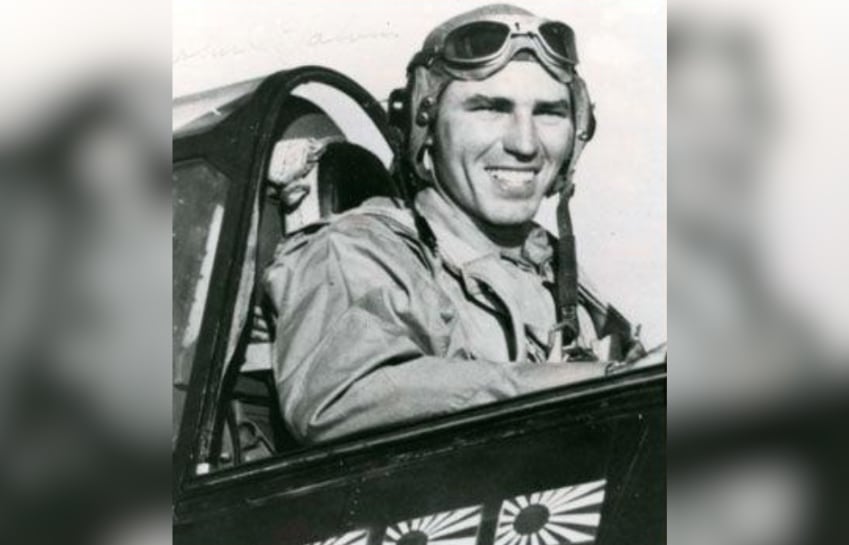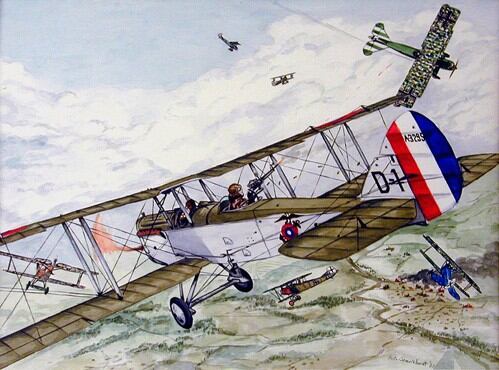The aviation and intelligence branch of the U.S. Army Signal Corps was evolving into the Army Air Service, when, on March 10, 1918, the Navy Department ordered four land squadrons to aid the British in bombing operations against German targets.
By early July, Navy and Marine aircrews — trained at French, British and Italian aerodromes — were ready and eager to enter the fray. But there were still no aircraft for them to fly. Considering the equipment shortage, many crew members were loaned out to RAF squadrons to gain combat experience.
Flying the Liberty DH-4 — British-designed de Havilland bombers with American-built Liberty V-12 engines — with the RAF’s No. 218 Squadron on Oct. 2, U.S. Marine Capt. Robert S. Lytle and Gunnery Sgt. Amil Wiman flew at dangerously low altitudes to deliver food and supplies to endangered troops. The duo also joined in two bombing raids.
The following day, the exhausted crew was spelled by 2nd Lt. Ralph Talbot and Gunnery Sgt. Robert G. Robinson, who flew numerous bombing sorties over the subsequent days.
RELATED

Born in Weymouth, Massachusetts, on Jan. 6, 1897, Ralph Talbot studied at Yale before taking an interest in aviation. When war broke out he joined the Navy in October 1917, but transferred to a second lieutenant’s commission in the Marine Corps Reserve to see more action.
Talbot’s bombardier, Robinson, was born in Wayne, Michigan, on April 30, 1894, and had been wounded on the ground before being reassigned to Talbot’s back seat.
When nine German fighters attacked the British flight during a raid on Ardoye on Oct. 8, Talbot and Robinson flew alone to aggressively engage the enemy planes and were credited with shooting down one.
On Oct. 14 the Marines finally had the aircraft numbers necessary for C Squadron, First Marine Aviation Force, to launch the Day Wing’s first independent operation from France’s Le Fresne Aerodrome, with Capt. Lytle leading eight aircraft against German railways and yards located in the Belgian city of Thielt.
One plane dropped out with engine trouble, but the rest dropped 2,000 pounds of bombs on target. On the way back, the Marines came under attack by 11 German fighters.
Signaling his pilots to tighten up their formation, Lytle and Wiman fought off the leading German aircraft, then sent the second one spiraling out of control.

Meanwhile, two bombers had fallen behind due to engine trouble and the Germans were singling out one of them — crewed by Talbot and Robinson. A round fired from the German fighter struck Robinson, shattering his left elbow and leaving his arm hanging by a single tendon.
Robinson fought on until a cartridge jammed in his weapon. Seeing his gunner’s plight, Talbot turned on his attackers, only to suffer jammed guns as well. Talbot’s aggressive move, however, bought Robinson enough time to clear his weapon’s jam using just his right hand.
Robinson resumed firing and may have struck one of the enemy planes before being hit again, this time in the stomach and thigh. He then collapsed unconscious on the DH-4′s cables.
With great difficulty, Talbot manhandled his plane around to fly headlong at another German aircraft, bluffing the enemy pilot into turning away. Talbot then dived low and crossed the lines at an altitude of just 50 feet.
Not wishing to force-land his riddled bomber with his bombardier suffering from 13 wounds, Talbot flew on to the Hondschoote Aerodrome, which he knew had a field hospital.
There, the surgeon-general of the Belgian army took a personal hand in successfully grafting Robinson’s arm back on.
Talbot’s aircraft was also patched up in time for him to fly it in the Marines’ next raids on Oct. 17 and 18. On Oct. 25, however, Talbot and 2nd Lt. Colgate W. Darden, Jr. were taking the plane up for an engine test when they failed to clear a bomb embankment trench at the end of the field.
The plane flipped over, throwing Darden clear with serious injuries, but trapping Talbot in the cockpit as it crashed into a pile of bombs and exploded in flames, killing him. Talbot was 21 years old.
On Nov. 11, 1920, Talbot and Robinson were both awarded the Medal of Honor for their actions on Oct. 14, 1918, making them the first two Marine aviators to receive the award.
Robinson eventually recovered from his wounds and lived until the age of 80. He died at his home in St. Ignace, Michigan, on Oct. 5, 1974.





